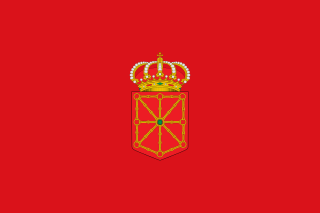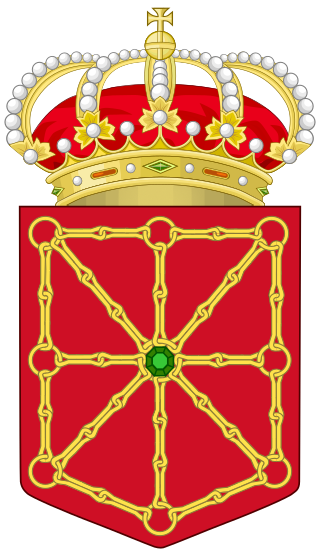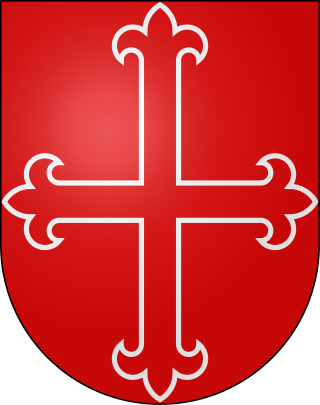
Navarre, officially the Chartered Community of Navarre, is a landlocked foral autonomous community and province in northern Spain, bordering the Basque Autonomous Community, La Rioja, and Aragon in Spain and Nouvelle-Aquitaine in France. The capital city is Pamplona. The present-day province makes up the majority of the territory of the medieval Kingdom of Navarre, a long-standing Pyrenean kingdom that occupied lands on both sides of the western Pyrenees, with its northernmost part, Lower Navarre, located in the southwest corner of France.

Basque nationalism is a form of nationalism that asserts that Basques, an ethnic group indigenous to the western Pyrenees, are a nation and promotes the political unity of the Basques, today scattered between Spain and France. Since its inception in the late 19th century, Basque nationalism has included Basque independence movements.

Lower Navarre is a traditional region of the present-day French département of Pyrénées-Atlantiques. It corresponds to the northernmost merindad of the Kingdom of Navarre during the Middle Ages. After the Spanish conquest of Iberian Navarre (1512–24), this merindad was restored to the rule of the native king, Henry II. Its capitals were Saint-Jean-Pied-de-Port and Saint-Palais. In the extreme north there was the little sovereign Principality of Bidache, with an area of 1,284 km2 (496 sq mi) and a decreasing population of 44,450, 25,356.

The Kingdom of Navarre, originally the Kingdom of Pamplona, was a Basque kingdom that occupied lands on both sides of the western Pyrenees, with its northernmost areas originally reaching the Atlantic Ocean, between present-day Spain and France.

Fuero, Fur, Foro or Foru is a Spanish legal term and concept. The word comes from Latin forum, an open space used as a market, tribunal and meeting place. The same Latin root is the origin of the French terms for and foire, and the Portuguese terms foro and foral; all of these words have related, but somewhat different meanings.

The Southern Basque Country refers to the Basque territories within Spain as a unified whole.

Medrano may refer to:

The Spanish conquest of the Iberian part of Navarre was initiated by Ferdinand II of Aragon and completed by his grandson and successor Charles V in a series of military campaigns lasting from 1512 to 1524. Ferdinand was both the king of Aragon and regent of Castile in 1512. When Pope Julius II declared a Holy League against France in late 1511, Navarre attempted to remain neutral. Ferdinand used this as an excuse to attack Navarre, conquering it while its potential protector, France, was beset by England, Venice, and Ferdinand's own Italian armies.
Ladrón Íñiguez, also known as Ladrón Navarro, was a leading nobleman of the Kingdom of Navarre during the reign of García Ramírez (1134–50), whose accession he was instrumental in bringing about. He is regularly titled count (comes), the highest rank in the kingdom, after 1135. He is recorded in contemporary documents with the title princeps Navarrorum. Between 1124 and his death he was the effective ruler of the Basque country (Euskadi).
The General Assemblies is the name of the legislative body (legislature) of the Spanish Basque territories of Biscay, Gipuzkoa, Alava and Navarre, and the elected assemblies to which the Government of each territory is responsible. The northern, French Basque Country, had its own regional assemblies until the Napoleonic period.

The coat of arms of Navarre is the heraldic emblem which for centuries has been used in Navarre. It was adopted as one of the official symbols of the Chartered Community of Navarre and is regulated by Foral Law 24/2003. It is commonly used by Navarrese municipalities in their own arms.

Amaiur-Maya is a village in the municipality of Baztan in the autonomous region of Navarre in Spain. It is situated in the Pyrenees mountain range close to the border with France.
The end of Basque home rule or fueros in Spain was a process coming to a head in the period extending from the First Carlist War (1833-1840) to the aftermath of the Third Carlist War (1876-1878). It brought to an end the status of sovereignty coupled with allegiance to the Crown of Castile held by the different Basque territories for centuries. In the French Basque Country, home rule was abruptly suppressed during the French Revolution.
The Gamazada is the popular reaction in Navarre in 1893 and 1894 to when the Spanish finance minister of the Liberal Party under Prime Minister Sagasta, Germán Gamazo, tried to suppress the fueros that had been established in the Compromise Act of 1841. It caused a huge uproar among the people and institutions of Navarre, with demonstrations and petitions.

Juan Martínez de Medrano y Aibar, nicknamed the Elder or the Mayor, baron and lord of Arroniz, Sartaguda, Viana and Villatuerta, was regent of the Kingdom of Navarre from 13 March 1328 until 27 February 1329. Don Juan Martínez de Medrano y Aibar was a ricohombre, alcaide and prominent figure of the Navarrese high nobility and main head of his lineage. Juan participated in the most relevant political events that occurred in the Kingdom of Navarre in the first half of the 14th century. Juan Martínez de Medrano and his son Álvaro Diaz de Medrano are known for their modifications or amendments (amejoramientos) of the Fueros, commissioned in 1330 by King Philip III of Navarre. Carlos II of Navarre, for his services, gave Juan the Castle of Dicastillo and shortly after the town of Arróniz. He was the Lieutenant of the Governor of Navarre, a position he held from 1329–1330, and Judge of the Corte of Navarre.

Juan Vélaz de Medrano IV was the royal Chamberlain for King Charles III of Navarre in 1414 and King John II of Aragon and Navarre in 1432. Juan was a noble and knight from the Kingdom of Navarre. He was the lord of Igúzquiza, Arguiñano, Arzoz, Learza, Artazu, Zabal, Orendáin, and the alcaide of Monjardín Castle and Viana. He is the son of the ricohombre Don Alvar Diaz de Medrano y Almoravid. Don Juan Vélaz de Medrano was active in the Hundred Years' War during the war of Languedoc (1412), the civil war in Aragon (1412) and successfully defended Viana against the Kingdom of Castile in 1429–1430. In 1410, Don Juan Vélaz de Medrano was targeted in a rebellion from his fiefdom of Orendáin. His grandsons Juan and Jaime Vélaz de Medrano y Echauz were leaders in the defense against the conquest of Navarre, particularly in 1512 and 1522.

The Palace of Vélaz de Medrano is the former seat and residence of the noble Medrano family in Igúzquiza, Navarre. It was directly linked to the perpetual lordship of Igúzquiza, held by the same noble family. The castle-palace of Vélaz de Medrano is currently privately owned and listed in the Spanish Historical Heritage, obtaining the protection of the generic declaration of the Spanish Historical Heritage decree on April 22, 1949, and protected by Law 16/1985 of June 25, 1985.

Jaime Vélaz de Medrano y Echauz was a noble from the House of Medrano in the independent Kingdom of Navarre. He was a knight of Navarre, a royal guard of the king, captain of the kings standing army, alcaide and mayor of Amaiur-Maya and one of the leading defenders of the Navarrese crown against the Spanish conquest of Iberian Navarre. Jaime Vélaz de Medrano is believed to have served as the alcaide of Maya Castle from 2 October 1521, to 19 July 1522.

José Joaquín Vélaz de Medrano y Gante, 1st Marquess of Fontellas 1st Viscount of Amaláin, 7th Viscount of Azpa, Lieutenant of the Royal Spanish Guards, 14th lord of Fontellas, lord of Autol, Knight of the Order of Malta, representative to the General Courts for the military branch, alcalde of Pamplona and a member of the Cortes of Navarre. He was created 1st Viscount of Amaláin and the 1st Marquess of Fontellas by Royal decree on April 19, 1793, by Charles IV of Spain. He was born in Pamplona and died unmarried in Fontellas on 10 February 1826. His nephew Don Fernando Vélaz de Medrano y Alava succeeded him as the II Marquess of Fontellas.













